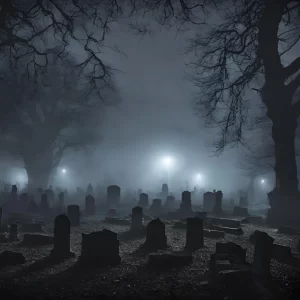St. Philip’s Graveyard

For the casual taphophile, a city such as Charleston, South Carolina, with so many historic graveyards and cemeteries, can be overwhelming. Each one has its own stories and spirits, markers and monuments and unique design to it. The simple, yet elegant, layout of St. Philips graveyard has made it a top choice for those that love the macabre and magnificent. Connected to the St. Philips Church, one of many in the Holy City.
A city where hundreds of dissenters from various branches of Catholicism flocked too in 1670. The congregation itself was founded in 1681, and they have been at their location on Church Street since 1723. The section to the west of the church was originally designated for the burial of “strangers and transient white persons” but eventually became the final resting place for respected members of the church as well. The landscape sews together the story of South Carolina; colonial leaders, a vice president, a playwright, and a president of the state all rest here. A mourning woman whose spirit looms over her lost child’s grave also mystifies visitors each and every year.
Join Charleston Terrors to discover more haunted locations!
St. Philip’s Congregation
Originally established in 1681, St. Philip’s congregation originally formed further away at the intersection of Broad and Meeting Street. Where the St. Michael’s Episcopal Church currently sits. In 1710, a hurricane struck the city and destroyed the original wooden building. Built with black cypress, it stood no chance against the torrent winds of the Atlantic. The hurricane of 1710 was one of many storms that wrecked the Carolina coastline on the 18th.
This greatly delayed the development of the area, but all the while, it was redesigned into the beautiful complex smattering of churches we see today. St. Philip’s Church was yet again destroyed in 1835. A larger brick building had been burned down in a disastrous fire. Construction began almost immediately, and the fine Anglo-Palladian-style building we see today was reopened in 1838. In 1848 and 1850, the steeple was added, and the building has stood strong since.
Among those who attended service here were some of the earliest political leaders of South Carolina. Several early colonial leaders rest in the graveyard, including Edward Rutledge, a signer of the Declaration of Independence. Rawlins Lowndes, a former President of South Carolina, ratified the removal of the term President in favor of Governor when he became executive in chief of the colony in 1778.
He opposed the Constitution due to its restrictions on the slave trade and the stark shift of power it proposed from the state level to the federal government. Other famous residents of the graveyard include DuBose Heyward, who wrote the novel Porgy. His work would go on to influence Porgy and Bess, the 1935 George Gershwin Opera. Heyward wrote the words of this smashing production, and it would go on to be dramatized in the 1959 film of the same name. Heyward, born in Charleston, would pass away in 1940. His spirit, and those of the aforementioned, all appear to be at rest. That is not the case for all who lay here.
The Grieving Woman
In 1987, a man named Harry Reynolds took a stroll over to St. Philip’s Graveyard. It was a nice sunny day, and he wanted to capture the beauty of the cemetery. Little did he know that one of the photos he took would captivate ghost enthusiasts for years to come. What he captures in the film is almost beyond belief, purely in the purity of the subject.
Reynolds managed to capture the image of a transparent woman hunched over the grave of a small child. She is kneeling on the ground on both her hands and feet as if suffering a terrible loss. This is the supposed ghost of Sue Howard, a former member of the St. Philip’s Congregation. Howard and her husband Gaston Hardy lost their stillborn child on June 10th, 1888. Six days later, Sue mysteriously fell ill and died. Many say she died of a broken heart.
When this picture was developed, it was picked up by many publications and tabloids around the world. Charlestonians knew who she was right away. Her story is a common folk around the Charleston area. The photo itself is said to have harmful effects on pregnant women who touch it. They feel sick and uneasy. Some even report harmful physical sensations.
Sue Howard is far from the only spirit wandering St. Philip’s Graveyard. Many see the spirit of a young girl holding a cane walking late at night through the tombs. The story goes that she was dared by friends of hers to enter the cemetery at night and leave a cane at the tomb of a man named Boney. Boney was an African slave who saved the church from a great fire in 1796 and was given his freedom for doing so.
He was buried in the graveyard, and folklores say that his spirit is still haunting it today. The poor girl got so worked up over the tale that, after being frightened by a sound, she accidentally pitched herself into the ground like a tent with her cane. Reportedly dying of pure fright.
St. Philip’s Spirits
While folks do say they see her spirit late at night, there is no reference to this actually happening. Except for Boney, that is. He was a real-life person who truly saved the church from destruction. His spirit, it said, still haunts the graveyard, protecting his congregation from whatever evil may try to approach them. The girl, the grieving woman, they are all there. The founding fathers and inspired authors. They are waiting for adventurers brave enough to see the sights and sounds of St. Philip’s Graveyard for themselves.
If you feel brave enough, take a tour with Charleston Terrors and see for yourself. Until then, however, you can keep reading our blog for more scary stories and cemetery tales.
Sources:
https://www.nga.org/governor/rawlins-lowndes/
https://www.stphilipschurchsc.org/history
https://travelerofcharleston.com/attractions/st-phillips-church-graveyard/
https://www.southernspiritguide.org/a-holy-ghost-at-st-philips/
https://scaresandhauntsofcharleston.wordpress.com/2012/03/13/the-photograph-of-sue-howard-hardy/
https://charlestonterrors.com/haunted-charleston-most-haunted-places-3-st-phillips-episcopal-church/
https://www.walkingcharleston.com/blog/2017/10/5/historic-graveyards-and-cemeteries
https://www.britannica.com/biography/DuBose-Heyward

